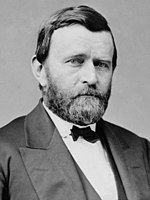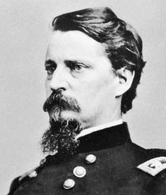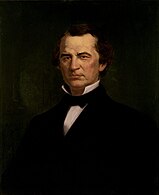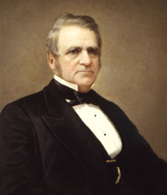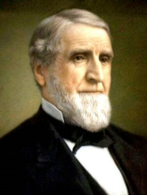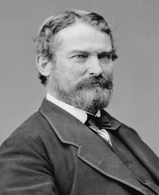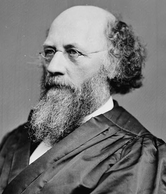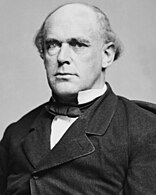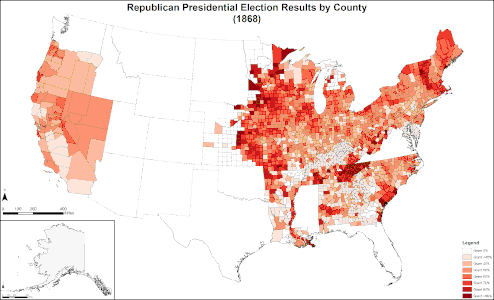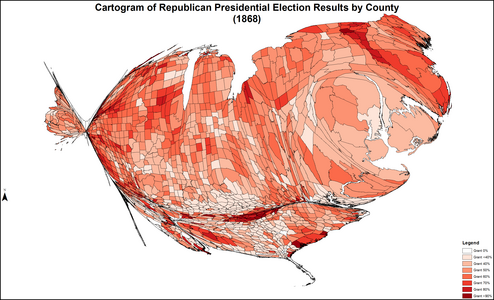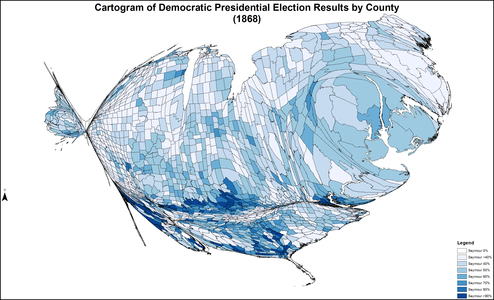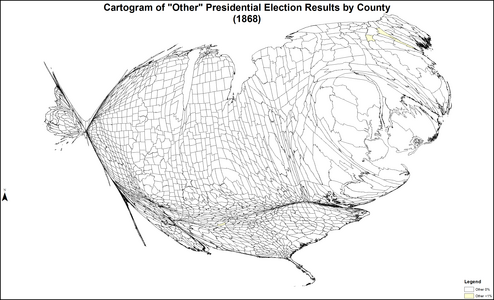用戶:FK8438/翻譯
| |||||||||||||||||||||||||||||
294張選舉人票 獲勝需148 選舉人票票 | |||||||||||||||||||||||||||||
|---|---|---|---|---|---|---|---|---|---|---|---|---|---|---|---|---|---|---|---|---|---|---|---|---|---|---|---|---|---|
| 投票率 | 78.1%[1] ▲ 4.3 pp | ||||||||||||||||||||||||||||
| |||||||||||||||||||||||||||||
Template:1868 United States presidential election imagemap 紅色 底色的州份為共和黨Grant/Colfax所獲勝的州份, 藍色 底色的州份為民主黨Seymour/Blair所獲勝的州份, 綠色 州份代表該州因內戰而無法參與選舉。 | |||||||||||||||||||||||||||||
| |||||||||||||||||||||||||||||
1868年美國總統選舉是第21次美國總統選舉,也是美國重建時期的第一次選舉,於1868年11月3日舉行。這次選舉中,共和黨候選人尤利西斯·S·格蘭特擊敗了民主黨的霍雷肖·西摩。這是美國內戰結束和廢除奴隸制後舉行的第一次總統選舉。根據第一次重建法案,這是非裔美國人可以在重建的南部各州投票的第一次選舉。 1865 年,在共和黨人亞伯拉罕·林肯林肯遇刺案後,現任總統安德魯·約翰遜繼任總統。來自田納西州的戰時民主黨人約翰遜曾在 1864 年擔任林肯的競選夥伴,獲得了全國聯盟的票,該票旨在吸引共和黨人和戰時民主黨人。上任後,約翰遜與共和黨國會就重建政策發生衝突,遭到彈劾,差點被免職。約翰遜在 1868 年的民主黨全國代表大會上獲得了連任的一些支持,但經過幾次投票後,大會提名了曾擔任紐約州州長的西摩。 1868 年共和黨全國代表大會一致提名格蘭特,他是內戰結束時最高級別的聯邦將軍。民主黨人批評共和黨的重建政策,並「明確地在反黑人、親白人的平台上進行競選」,[2] 而共和黨人則以格蘭特的聲望和聯盟在內戰中的勝利為目標進行競選。 格蘭特贏得了選舉人票,但他在普選中的差距較小。除了他在北方的吸引力之外,格蘭特還受益於南方新獲得選舉權的自由人的選票,而許多南方白人的政治權利暫時被剝奪有助於共和黨的優勢。由於三個前同盟州(德克薩斯州、密西西比州和弗吉尼亞州)尚未恢復聯邦,他們的選民無法在選舉中投票。
選舉背景
[編輯]美國奴隸制度和重建和公民權利在聯邦中是一個備受爭議的問題。格蘭特支持國會激進共和黨人的重建計劃,該計劃支持第14條修正案,賦予自由人充分的公民權利,包括男性選舉權。 民主黨綱領譴責共和黨的「黑人至上主義」,並要求恢復各州的權利,包括南部各州自行決定是否允許成年自由人選舉權的權利。共和黨人指責民主黨人決心拒絕任何自由人的投票,無論是否健康。 而民主黨人指責共和黨人想給所有被釋放的人投票,不管他們是否健康。
Nominations
[編輯]共和黨總統候選人初選
[編輯]
| 1868年共和黨票 | |||||||||||||||||||||||||||||
| 尤利西斯·格蘭特 | 史凱勒·科法斯 | ||||||||||||||||||||||||||||
|---|---|---|---|---|---|---|---|---|---|---|---|---|---|---|---|---|---|---|---|---|---|---|---|---|---|---|---|---|---|
| 總統 | 副總統 | ||||||||||||||||||||||||||||
 |
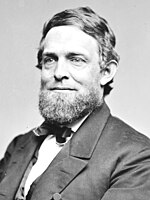 | ||||||||||||||||||||||||||||
| 第6屆 美國陸軍司令部指揮官 (1864–1869) |
第25屆 美國眾議院議長 (1863–1869) | ||||||||||||||||||||||||||||
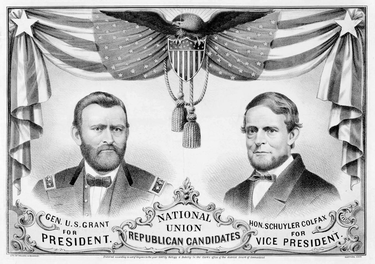 | |||||||||||||||||||||||||||||
到了 1868 年,共和黨想獨立的為該黨的總統候選人提名一位受歡迎的總統候選人。在選舉前,民主黨控制了許多北方大州,這些州擁有很大比例的選舉人票。尤利西斯·S·格蘭特加入了共和黨,並在1868年5月20日至21日在伊利諾伊州的芝加哥舉行的共和黨大會的第一次投票中被提名為該黨的參選人。眾議院議長史凱勒·科法斯在第六輪投票中被提名為副總統,擊敗了早期最受歡迎的俄亥俄州參議員 本傑明·韋德。 共和黨的綱領支持南方的黑人選舉權,作為前奴隸的黑人應該獲得完全的美國公民身份。共和黨亦支持讓北部各州單獨決定是否賦予黑人選舉權。當時,該黨的主要政見為反對使用美元贖回美國債券,鼓勵移民,支持歸化公民的全部權利等,並贊成激進重建派而不是安德魯·約翰遜總統更為寬鬆的政策。[2]
民主黨候選人初選
[編輯]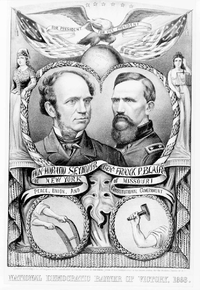
| 1868 Democratic Party ticket | |||||||||||||||||||||||||||||
| Horatio Seymour | Francis Preston Blair Jr. | ||||||||||||||||||||||||||||
|---|---|---|---|---|---|---|---|---|---|---|---|---|---|---|---|---|---|---|---|---|---|---|---|---|---|---|---|---|---|
| 總統 | 副總統 | ||||||||||||||||||||||||||||
 |
|||||||||||||||||||||||||||||
| 18th Governor of New York (1853–1854 & 1863–1864) |
Former U.S. Representative for Missouri's 1st (1857–1859, 1860, 1861–1862, & 1863–1864) | ||||||||||||||||||||||||||||
| Campaign | |||||||||||||||||||||||||||||

| |||||||||||||||||||||||||||||
民主黨全國代表大會於1868年7月4日至9日在紐約市舉行。在黨內預選投票中的領先者是喬治·H·彭德爾頓(George H. Pendleton)(1864 年民主黨副總統候選人),他在前15次黨內投票中領先,隨後在不同的投票中領先。 由 Andrew Johnson 總統、Winfield Scott Hancock、Sanford Church、Asa Packer、Joel Parker、James E. English、James Rood Doolittle 和 Thomas A. Hendricks 訂購。 不受歡迎的約翰遜勉強在彈劾不通過後,在第一輪投票中贏得了65票,未達到提名所需總票數的三分之一,因此失去了競選總統的資格。 與此同時,大會主席、前紐約州州長霍雷肖·西摩在北卡羅來納州的第四輪投票中獲得了九票。 這一出人意料的舉動引起了「熱烈的歡呼」,但西摩對此表示拒絕,並說道:
I must not be nominated by this Convention, as I could not accept the nomination if tendered. My own inclination prompted me to decline at the outset; my honor compels me to do so now. It is impossible, consistently with my position, to allow my name to be mentioned in this Convention against my protest. The clerk will proceed with the call.[3]
By the seventh ballot Pendleton and Hendricks had emerged as the two front-runners, with Hancock the only other candidate with much support by this point. After numerous indecisive ballots, the names of John T. Hoffman, Francis P. Blair, and Stephen Johnson Field were placed in nomination, but none of these candidates gained substantial support.
For 21 ballots, the opposing candidates battled it out: the East battling the West for control, the conservatives battling the radicals. Pendleton's support collapsed after the 15th ballot, but went to Hancock rather than Hendricks, leaving the convention still deadlocked. The two leading candidates were determined that the other should not receive the presidential nomination; because of the two-thirds rule of the convention, a compromise candidate was needed. Seymour still hoped it would be Chief Justice Salmon P. Chase, but on the 22nd ballot, the chairman of the Ohio delegation announced, "at the unanimous request and demand of the delegation I place Horatio Seymour in nomination with 21 votes—against his inclination, but no longer against his honor."
Seymour had to wait for the rousing cheers to die down before he could address the delegates and decline.
…如果不將我自己和民主黨置於錯誤的位置,我就無法獲得提名。上帝保佑你對我的善意,但我不能成為你的候選人。 …
"Take the nomination, then!" cried someone from the floor.
... but when I said that I could not be a candidate, I mean it! I could not receive the nomination without placing not only myself but the Democratic party in a false position. God bless you for your kindness to me, but your candidate I cannot be.[4]
Seymour left the platform to cool off and rest. No sooner had he left the hall than the Ohio chairman cried that his delegation would not accept Seymour's declination; Utah's chairman rose to say that Seymour was the man they had to have. While Seymour was waiting in the vestibule, the convention nominated him for president unanimously.
Exhausted, the delegates unanimously nominated General Francis Preston Blair, Jr., for vice president on the first ballot after John A. McClernand, Augustus C. Dodge, and Thomas Ewing, Jr., withdrew their names from consideration. Blair's nomination reflected a desire to balance the ticket east and west as well as north and south.[5]
Blair had worked hard for the Democratic vice presidential nomination and accepted second place on the ticket, finding himself in controversy.[6] He had gained attention for an inflammatory letter addressed to Colonel James O. Broadhead, dated a few days before the convention met, in which he wrote that the "real and only issue in this contest was the overthrow of Reconstruction, as the radical Republicans had forced it in the South."[7]
General election
[編輯]Campaign
[編輯]
The 1868 campaign of Horatio Seymour versus Ulysses S. Grant was conducted vigorously, being fought out largely on the question of how Reconstruction should be conducted.[8]
The Republicans were fearful as late as October that they might be beaten.[9]
Grant's antisemitic General Order No. 11 during the Civil War became a campaign issue. He apologized in a letter for the controversial order. In his army days he had traded at a local store operated by the Seligman brothers, two Jewish merchants who became Grant's lifelong friends. They became wealthy bankers who donated substantially to Grant's presidential campaign.[10]

Grant took no part in the campaign and made no promises. The Republican campaign theme, "Let us have peace," was taken from his letter of acceptance. After four years of civil war, three years of wrangling over Reconstruction, and the attempted impeachment of a president, the nation craved the peace Grant pledged to achieve.
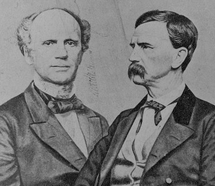
Seymour answered none of the charges made against him, but made a few key speeches. Some newspapers exaggerated his faults. As governor, Seymour had sent troops to Gettysburg, but some press tried to portray him as disloyal to the Union. The New York Tribune led the cartoon campaign with the picture of Seymour standing on the steps of the City Hall calling a mob of New York draft rioters "my friends." The Hartford Post called him "almost as much of a corpse" as ex-President James Buchanan, who had just died. Additionally, Republicans alleged that insanity ran through the Seymour family, citing as evidence the suicide of his father.
Blair went on a national speaking tour in which he framed the contest with Ulysses S. Grant and the pro-Reconstruction Republicans in stark racial terms, warning of the rule of "a semi-barbarous race of blacks who are worshipers of fetishes and poligamists" and wanted to "subject the white women to their unbridled lust." Republicans advised Americans not to vote for Seymour, as Blair might succeed him.[11]
| Northern and Southern Democratic Sheet Music |
|---|
Blair had a reputation for outspokenness and his campaign speeches in 1868 attacked Radical Republicans.[12] Samuel J. Tilden, a member of the national committee, asked Blair to confine his campaigning to Missouri and Illinois for fear he "would hurt the ticket" because of his stance on Reconstruction.[13]
Seymour, who had not taken an active role in the campaign to this point, went into the canvass, seeking to steer the campaign away from the harshness of Blair's attacks on Radical Reconstruction. Seymour emphasized his idea that change in the South should be accomplished at the state level, without national interference. The Democrats campaigned for immediate restoration of all states, the "regulation of the elective franchise in the states by their citizens", and amnesty for past political offenses,[8] while State civil authority should take precedence over military action. The president and the Supreme Court should be respected rather than attacked, as he claimed the Republicans had done. The Democrats would be careful to reorder national priorities.[14]
Results
[編輯]Horatio Seymour 獲得 2,708,744 票,格蘭特獲得 3,013,650 票。 民眾投票的接近程度令當時的政治精英感到驚訝。 [15]共和黨眾議員詹姆斯 G. 布萊恩稱格蘭特的微弱多數是「一個非常令人吃驚的事實。」[16] 布萊恩是一位敏銳的民意判斷者,無法解釋民主黨投票的規模。 [17]愛爾蘭裔天主教徒和其他移民已經在紐約定居了近四分之一個世紀。 Seymour 以極小的劣勢輸掉了印第安納州、康涅狄格州和賓夕法尼亞州等北部地區的選舉人票,以及南部新黑人選票的影響,這引發了人們對大多數白人投票給 Seymour 的懷疑。 民主黨在南方表現不佳,新獲釋的非裔美國人大量投票。除了喬治亞州和路易斯安那州之外,共和黨人佔據了南部的每個州,在那裏,三K黨和白茶花騎士團的暴力和欺詐行為讓民主黨人佔了多數。 [19]
沿着邊境,肯塔基州、馬里蘭州和特拉華州以壓倒性優勢走向民主黨,在肯塔基州的情況下,受到對激進重建主義者的敵意影響,這導致該州第一個戰後政府幾乎完全由前同盟國組成。 [20]在肯塔基州[21] 或馬里蘭州[22] 之前或之後,沒有哪位民主黨總統候選人獲得更高的選票百分比,在這些地方,對黑人選舉權的敵意非常普遍。 [23] As for Delaware,[24] only the Democratic tickets of Johnson/Humphrey in 1964 (which was elected with the largest percentage of the popular vote since 1824) and Obama/Biden in 2008 (which had the first Delawarean on a national ticket) carried得票率較高的州。
兩個邊境州,密蘇里州和西弗吉尼亞州,都在共和黨的控制之下,將他們的選舉人票投給了格蘭特。 [25]西摩勉強帶着他的家鄉紐約州,但貝理雅,主要是因為激進黨的登記系統,沒能帶着密蘇里州。密蘇里州民主黨人高興地說:「貝理雅將軍在他的選區、他的城市、他的縣和他的州遭到毆打。」 [26] 在西弗吉尼亞州,前同盟者被暫時禁止投票或擔任公職。據估計,有 15,000 至 25,000 名白人居民因此被剝奪了選舉權。 [27]
Of the 1,708 counties making returns, Grant won 991 (58.02%) and Seymour 713 (41.74%). Four counties (0.23%) split evenly between Grant and Seymour. Hence the Democrats, even with all the burdens of the war, still carried only 278 fewer counties than the Republicans. That cemented a solid party comeback at the grassroots level that had begun in local elections in 1867.[15]
The 1868 election is the only election since the Civil War in which the two major party candidates won over 99.9% of the vote.[16] Out of a total of over 5.7 million votes, just 46 ballots were cast for anyone other than Grant and Seymour.[17]
That was the last election in which the Republicans won Tennessee until 1920, the last in which the Democrats won Oregon until 1912, and the last in which the Republicans won Missouri until 1904.
That Grant lost New York to Seymour by 10,000 votes was a source of shame and anger to Republicans. Seymour's victory in New York was made the subject of a federal investigation. On November 4, Horace Greeley spoke at the Union League Club. The ULC promptly petitioned Congress to look into the state vote. The petition was presented to the House of Representatives on December 14 and accepted by a vote of 134-35 (52 abstained). Speaker of the House Schuyler Colfax, the Republican candidate for vice president, appointed a committee of seven: five Republicans and two Democrats. The committee was most likely created because the Republicans could not lose New York without a protest. It reported to the House of Representatives on February 23, 1869.[18] The committee decided to take no action, and Seymour retained New York's 33 electoral votes. He was willing to return to the subject as long as he lived.[19]
In a 1943 book, novelist Irving Stone suggested that if Seymour had carried all four of the October states (Pennsylvania, Ohio, Indiana, and Iowa), the Republican-controlled Congress would have acted to prevent the possibility of any Southern states supporting the Democratic ticket. Stone claimed that the only way the Democrats could have won was by carrying every close state in the North and retaining both Georgia and Louisiana. Georgia's vote was contested at the electoral count, with the Republicans claiming the Democrats won only by "violence, fraud and intimidation," and it likely would have been disallowed if the Democratic victory had been decisive.[9]
According to Seymour's biographer, Stewart Mitchell, the Republican Party claimed credit for saving the Union and was bound, bent, and determined to continue to rule it.[20] The margin of Grant's popular majority resulted largely from winning a high percentage of the half-million newly enfranchised men or color.[9] This strategy contrasted strongly with later years, when Republicans permitted complete black disfranchisement in the former Confederate states, since they had many new and secure votes in new states in the Western United States.[21]
| 總統候選人 | 政黨 | 出身 | 普選票(a) | 選舉人票 (a) |
競選夥伴 | |||
|---|---|---|---|---|---|---|---|---|
| 數目 | 比例 | 副總統候選人 | 出身 | 選舉人票(a) | ||||
| Ulysses S. Grant | Republican | Illinois | 3,013,650 | 52.66% | 214 | Schuyler Colfax Jr. | Indiana | 214 |
| Horatio Seymour | Democratic | New York | 2,708,744 | 47.34% | 80 | Francis Preston Blair Jr. | Missouri | 80 |
| 其他 | 46 | <0.01% | — | 其他 | — | |||
| 總計 | 5,722,440 | 100% | 294 | 294 | ||||
| 獲勝需要 | 148 | 148 | ||||||
Source (Popular Vote): Template:Leip PV source Source (Electoral Vote): Electoral College Box Scores 1789–1996. Official website of the National Archives. (July 31, 2005). (a) Mississippi, Texas, and Virginia did not participate in the election of 1868 due to Reconstruction. In Florida, the state legislature cast its electoral vote for Grant by a vote of 40 to 9.
Geography of results
[編輯]Cartographic gallery
[編輯]-
Map of presidential election results by county
-
Map of Republican presidential election results by county
-
Map of Democratic presidential election results by county
-
Map of "other" presidential election results by county
-
Cartogram of presidential election results by county
-
Cartogram of Republican presidential election results by county
-
Cartogram of Democratic presidential election results by county
-
Cartogram of "other" presidential election results by county
Results by state
[編輯]Source: Data from Walter Dean Burnham, Presidential ballots, 1836–1892 (Johns Hopkins University Press, 1955) pp 247–57.[22]
| States/districts won by Seymour/Blair |
| States/districts won by Grant/Colfax |
| Ulysses S. Grant Republican |
Horatio Seymour Democratic |
Margin | State Total | ||||||||
|---|---|---|---|---|---|---|---|---|---|---|---|
| State | electoral votes |
# | % | electoral votes |
# | % | electoral votes |
# | % | # | |
| Alabama | 8 | 76,667 | 51.25 | 8 | 72,921 | 48.75 | - | 3,746 | 2.50 | 149,594 | AL |
| Arkansas | 5 | 22,112 | 53.68 | 5 | 19,078 | 46.32 | - | 3,034 | 7.36 | 41,190 | AR |
| California | 5 | 54,588 | 50.24 | 5 | 54,068 | 49.76 | - | 520 | 0.48 | 108,656 | CA |
| Connecticut | 6 | 50,788 | 51.49 | 6 | 47,844 | 48.51 | - | 2,944 | 2.98 | 98,632 | CT |
| Delaware | 3 | 7,614 | 41.00 | - | 10,957 | 59.00 | 3 | -3,343 | -18.00 | 18,571 | DE |
| Florida | 3 | - | - | 3[note 1] | - | - | - | - | - | - | FL |
| Georgia | 9 | 57,109 | 35.73 | - | 102,707 | 64.27 | 9 | -45,598 | -28.54 | 159,816 | GA |
| Illinois | 16 | 250,304 | 55.69 | 16 | 199,116 | 44.31 | - | 51,188 | 11.38 | 449,420 | IL |
| Indiana | 13 | 176,552 | 51.39 | 13 | 166,980 | 48.61 | - | 9,572 | 2.78 | 343,532 | IN |
| Iowa | 8 | 120,399 | 61.92 | 8 | 74,040 | 38.08 | - | 46,359 | 23.84 | 194,439 | IA |
| Kansas | 3 | 30,027 | 68.82 | 3 | 13,600 | 31.17 | - | 16,427 | 37.65 | 43,630 | KS |
| Kentucky | 11 | 39,566 | 25.45 | - | 115,889 | 74.55 | 11 | -76,323 | -49.10 | 155,455 | KY |
| Louisiana | 7 | 33,263 | 29.31 | - | 80,225 | 70.69 | 7 | -46,962 | -41.38 | 113,488 | LA |
| Maine | 7 | 70,502 | 62.41 | 7 | 42,460 | 37.59 | - | 28,042 | 24.82 | 112,962 | ME |
| Maryland | 7 | 30,438 | 32.80 | - | 62,357 | 67.20 | 7 | -31,919 | -34.40 | 92,795 | MD |
| Massachusetts | 12 | 136,379 | 69.76 | 12 | 59,103 | 30.23 | - | 77,276 | 39.53 | 195,508 | MA |
| Michigan | 8 | 128,560 | 56.98 | 8 | 97,060 | 43.02 | - | 31,500 | 13.96 | 225,620 | MI |
| Minnesota | 4 | 43,722 | 60.88 | 4 | 28,096 | 39.12 | - | 15,626 | 21.76 | 71,818 | MN |
| Missouri | 11 | 86,860 | 56.96 | 11 | 65,628 | 43.04 | - | 21,232 | 13.92 | 152,488 | MO |
| Nebraska | 3 | 9,772 | 63.91 | 3 | 5,519 | 36.09 | - | 4,253 | 27.82 | 15,291 | NE |
| Nevada | 3 | 6,480 | 55.39 | 3 | 5,218 | 44.61 | - | 1,262 | 10.78 | 11,698 | NV |
| New Hampshire | 5 | 37,718 | 55.22 | 5 | 30,575 | 44.76 | - | 7,143 | 10.46 | 68,304 | NH |
| New Jersey | 7 | 80,131 | 49.12 | - | 83,001 | 50.88 | 7 | -2,870 | -1.76 | 163,132 | NJ |
| New York | 33 | 419,888 | 49.41 | - | 429,883 | 50.59 | 33 | -9,995 | -1.18 | 849,771 | NY |
| North Carolina | 9 | 96,939 | 53.41 | 9 | 84,559 | 46.59 | - | 12,380 | 6.82 | 181,498 | NC |
| Ohio | 21 | 280,167 | 54.00 | 21 | 238,621 | 46.00 | - | 41,546 | 8.00 | 518,788 | OH |
| Oregon | 3 | 10,961 | 49.63 | - | 11,125 | 50.37 | 3 | -164 | -0.74 | 22,086 | OR |
| Pennsylvania | 26 | 342,280 | 52.20 | 26 | 313,382 | 47.80 | - | 28,898 | 4.40 | 655,662 | PA |
| Rhode Island | 4 | 12,993 | 66.49 | 4 | 6,548 | 33.51 | - | 6,445 | 32.98 | 19,541 | RI |
| South Carolina | 6 | 62,301 | 57.93 | 6 | 45,237 | 42.07 | - | 17,064 | 15.86 | 107,538 | SC |
| Tennessee | 10 | 56,628 | 68.43 | 10 | 26,129 | 31.57 | - | 30,499 | 36.86 | 82,757 | TN |
| Vermont | 5 | 44,167 | 78.57 | 5 | 12,045 | 21.43 | - | 32,122 | 57.14 | 56,212 | VT |
| West Virginia | 5 | 29,015 | 58.83 | 5 | 20,306 | 41.17 | - | 8,709 | 17.66 | 49,321 | WV |
| Wisconsin | 8 | 108,900 | 56.25 | 8 | 84,703 | 43.75 | - | 24,197 | 12.50 | 193,603 | WI |
| TOTALS: | 294 | 3,013,790 | 52.66 | 214 | 2,708,980 | 47.34 | 80 | 304,810 | 5.32 | 5,722,440 | US |
Close states
[編輯]Red font color denotes states won by Republican Ulysses S. Grant; blue denotes those won by Democrat Horatio Seymour.
States where the margin of victory was under 1% (8 electoral votes)
- California 0.48% (520 votes)
- Oregon 0.74% (164 votes)
States where the margin of victory was under 5% (93 electoral votes)
- New York 1.18% (9,995 votes)
- New Jersey 1.76% (2,870 votes)
- Alabama 2.50% (3,746 votes)
- Indiana 2.79% (9,572 votes)
- Connecticut 2.98% (2,944 votes)
- Pennsylvania 4.41% (28,898 votes)
States where the margin of victory was under 10% (35 electoral votes)
- North Carolina 6.82% (12,380 votes) (tipping point state for a Grant victory)
- Arkansas 7.37% (3,034 votes) (tipping point state for a Seymour victory)
- Ohio 8.01% (41,546 votes)
Statistics
[編輯]Counties with highest percent of vote (Republican)
- Hancock County, Tennessee 100.00%
- Monona County, Iowa 100.00%
- Ottawa County, Kansas 100.00%
- Jefferson County, Nebraska 100.00%
- McDowell County, West Virginia 100.00%
Counties with highest percent of vote (Democratic)
- St. Landry Parish, Louisiana 100.00%
- Lafayette Parish, Louisiana 100.00%
- Jackson Parish, Louisiana 100.00%
- De Soto Parish, Louisiana 100.00%
- Franklin Parish, Louisiana 100.00%
Counties with highest percent of vote (Other)
- DeKalb County, Alabama 0.70%
- Sullivan County, New Hampshire 0.11%
- Strafford County, New Hampshire 0.09%
- Carroll County, New Hampshire 0.02%
See also
[編輯]- American election campaigns in the 19th century
- First inauguration of Ulysses S. Grant
- History of the United States (1865–1918)
- History of the United States Democratic Party
- History of the United States Republican Party
- Reconstruction era
- Third Party System
- 1868 United States House of Representatives elections
- 1868 and 1869 United States Senate elections
- Ohio idea
Footnotes
[編輯]- ^ Voter Turnout in Presidential Elections. The American Presidency Project. UC Santa Barbara.
- ^ William DeGregorio, The Complete Book of U.S. Presidents, Gramercy, 1997
- ^ Irving Stone (1943), They Also Ran: The Story of the Men Who Were Defeated for the Presidency, Garden City, New York: Doubleday and Doran, pg. 280
- ^ Official proceedings of the National Democratic convention, held at New York, July 4-9, 1868 (Pg. 153)
- ^ William E. Parrish (1998), Frank Blair: Lincoln's Conservative, Missouri Biography Series, University of Missouri Press, pg. 254
- ^ Frank Blair: Lincoln's Conservative, William E. Parrish, pg. 260
- ^ Stewart Mitchell, Horatio Seymour of New York, Harvard University Press, 1938, p. 448
- ^ 8.0 8.1 Henry, Robert Selph; The Story of Reconstuction; p. 330-332 ISBN 9781568522548
- ^ 9.0 9.1 9.2 Henry; The Story of Reconstruction; pp. 345-346
- ^ Jonathan D. Sarna. When General Grant Expelled the Jews. 2012: 62. ISBN 9780805212334.
- ^ Stewart Mitchell, Horatio Seymour of New York, Harvard University Press, 1938, pg. 23
- ^ Mitchell (1938), Horatio Seymour, pp. 448-449
- ^ William E. Parrish, Frank Blair: Lincoln's Conservative, p. 255–256
- ^ William E. Parrish, Frank Blair: Lincoln's Conservative, pg. 258–259
- ^ Bergeron; Andrew Johnson's Civil War and Reconstruction; pp. 175-177
- ^ Kondik, Kyle; Coleman, J. Miles. Notes on the State of the 2020 Election. University of Virginia. November 12, 2020.
- ^ 1868 Presidential General Election Results. Dave Leip's Atlas of U.S. Presidential Elections.
- ^ Horatio Seymour of New York, Stewart Mitchell, pg. 474-475
- ^ 引用錯誤:沒有為名為
HoratioSeymour的參考文獻提供內容 - ^ Horatio Seymour of New York, Stewart Mitchell, pg. 484
- ^ Valelly, Richard M.; The Two Reconstructions: The Struggle for Black Enfranchisement University of Chicago Press, 2009, pp. 134-139 ISBN 9780226845302
- ^ 1868 Presidential General Election Data – National. [May 7, 2013].
Notes
[編輯]- ^ Due to the status of Reconstruction, no election was held; the three electoral votes were allocated by the Florida State Legislature to Grant.
Bibliography
[編輯]- American Annual Cyclopedia ... 1868 (1869), online, highly detailed compendium of facts and primary sources
- Coleman, Charles Hubert. The election of 1868 : the Democratic effort to regain control (1933) online
- Gambill, Edward. Conservative Ordeal: Northern Democrats and Reconstruction, 1865-1868. (Iowa State University Press: 1981).
- Edward McPherson. The Political History of the United States of America During the Period of Reconstruction (1875) large collection of speeches and primary documents, 1865–1870, complete text online.[The copyright has expired.]
- Prymak, Andrew. "The 1868 and 1872 Elections," in Edward O. Frantz, ed. A Companion to the Reconstruction Presidents 1865-1881 (Wiley Blackwell Companions to American History) (2014) pp 235–56 online
- Rhodes, James G. History of the United States from the Compromise of 1850 to the McKinley-Bryan Campaign of 1896. Volume: 6. (1920). 1865–72; detailed narrative history
- Simpson, Brooks D. Let Us Have Peace: Ulysses S. Grant and the Politics of War and Reconstruction, 1861-1868 (1991).
- Summers, Mark Wahlgren.The Press Gang: Newspapers and Politics, 1865-1878 (1994)
- Summers, Mark Wahlgren. The Era of Good Stealings (1993), covers corruption 1868-1877
Primary sources
[編輯]- Chester, Edward W A guide to political platforms (1977) pp 86–89 online
- Official proceedings of the National Democratic convention, held at New York, July 4-9, 1868
- Porter, Kirk H. and Donald Bruce Johnson, eds. National party platforms, 1840-1964 (1965) online 1840-1956
External links
[編輯]- Presidential Election of 1868: A Resource Guide from the Library of Congress
- 1868 popular vote by counties
- 1868 State-by-state Popular vote
- "How close were the US Presidential elections?" — Michael Sheppard, Massachusetts Institute of Technology, 2012
- Election of 1868 in Counting the Votes 互聯網檔案館的存檔,存檔日期October 6, 2017,.
Template:1868 United States presidential election Template:State Results of the 1868 U.S. presidential election Template:USPresidentialElections Template:Ulysses S. Grant

